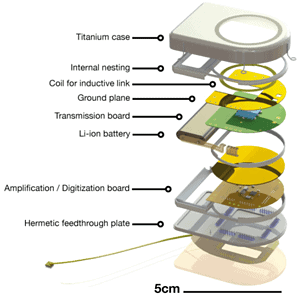
We’ve showed you some incredible brain-computer interface scientific advances in the past few weeks alone, be it the merged rat brain organic computer or flexible electronic “tattoo” that might enable functioning telepathy, and the field is only growing. We couldn’t be more happy, you can imagine, since the potential medical uses alone for this kind of technology are simply staggering. There are numerous unfortunate people all around the world with some form of paralysis or another or missing limbs, and a mechanical extension controlled by their very own thoughts is the best chance they currently have at living a normal life.
Luckily, brain-computer interface technology is growing furiously and a recent paper published by researchers at Brown University, which discuss their trials and findings after implanting a wirelessly rechargeable brain-computer interface device in animals adds even further weight. The implanted devices have been working for the past 12 months – a first in the brain-computer interface field.
Previously, brain-computer interfaces have been successful only with wired systems, aiding people with severe paralysis move devices like robotic arms or computer cursors by thinking about moving their arms and hands.
“This was conceived very much in concert with the larger BrainGate team, including neurosurgeons and neurologists giving us advice as to what were appropriate strategies for eventual clinical applications,” said Nurmikko, who is also affiliated with the Brown Institute for Brain Science.
Their device is 55 mm-long, and 9 mm thick – not quite negligible considering it needs to be implanted under the scalp – a consists of sophisticated electrical connections and a pill-sized chip, implanted in the cortex, which relays back important neural activity. In this “tin can”, a sophisticated array of electronics are housed, from lithium-ion batteries, to infrared transmitters, to signal processors, to wireless radio transmitters.
“What makes the achievement discussed in this paper unique is that it’s the first fully implanted neural interface microsystem operated wirelessly; and how it integrated many individual innovations into a complete system,” said lead author David Borton, a former Brown graduate student and postdoctoral research associate who is now at Ecole Polytechnique Federale Lausanne in Switzerland..
“It has operated more than 12 months in large animal models — a milestone for potential [human] clinical translation.”
After a two-hour charge, delivered wirelessly through the scalp via magnetic induction, it can operate for more than six hours.
“The device uses less than 100 milliwatts of power, a key figure of merit,” Nurmikko said.

Wireless brain-computer implants will finally allow people leave the house
The device have so far been implanted in the brains of six animals – three pigs and three rhesus macaque monkeys. So far, a slew of complex neural activity has been analyzed, data which is currently used in order to adapt the device for human us. Also, since the brian-computer interface solution is wireless, it can be used to monitor subject brain activity for various research purposes outside a lab. A lot of neural activity related to running or foraging for instance is almost impossible currently to assess without a wireless interface system.
In the experiments in the new paper, the device is connected to one array of 100 cortical electrodes, but the new device design allows for multiple arrays to be connected, Nurmikko said. That would allow scientists to observe ensembles of neurons in multiple related areas of a brain network.
Currently, the Brown researchers are working on an updated version that has even better data transmission (the current device ransmits data at 24 Mbps via 3.2 and 3.8 Ghz microwave frequencies), a reduced size and less health-related risks such that it may be soon considered for clinical trials.
Findings were reported in the Journal of Neural Engineering.






